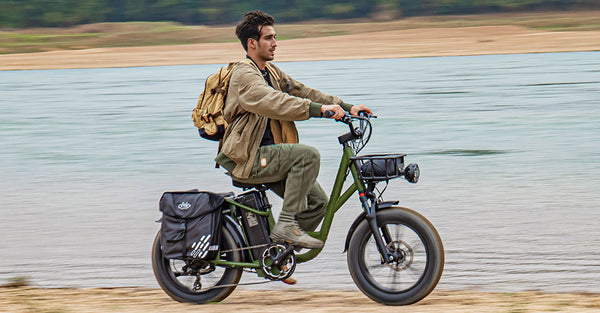You just bought your new electric bike and are ready to dominate the tracks like no other. However, you can't just start riding because you are wondering if you would need licenses. Well, not always. You may or may not need a license based on where you reside or your type of bike.
In this article, you'll learn all there is to know about electric bike licenses. You'll get to know whether or not you need one, as well as other crucial details.

What you Need to Know about Electric Bike Licenses in the US
Whether or not you need a license for your electric bike in the US depends on where you reside because most states have different laws. However, the majority of the states in the US don't require you to have a license to ride an electric bike because they're still considered regular bicycles.
The states that require you to have a license to operate an electric bike include Alabama, Alaska, Massachusetts, Missouri, North Dakota, Wisconsin, and New Mexico. Electric bikes are considered mopeds in these states, explaining why you need a license.
What are the Classes of Electric Bikes in the US?
You must know about the classes of electric bikes whether or not you reside in a location that requires licenses. You'll hear some of these a lot, and ride rules are usually different for them. There are three major classifications: class 1, class 2, and class 3.
Class 1 Electric Bikes
Class one electric bikes are the slowest and are referred to as low-speed electric bikes. They have a motor that helps with pedaling, but they have a top speed of 20mph.
Class 2 Electric Bikes
Class 2 Electric bikes are similar to class 1. However, the motor in the case continues to assist you even when the speed is 20mph, sometimes slightly more. Class 2 eBikes also have a throttle-only mode that lets the bicycle ride on itself without you needing to pedal. This type of bicycle can have more challenging roads than class 1.
Class 3 Electric Bikes
Class 3 e-bikes have a motor that also assists you when you pedal. However, they let you reach speeds of up to 28mph, which is when it stops. It's the most unpopular among electric bikes, as most jurisdictions keep you from reaching such speed on the machine. Class 3 e-bikes are also the ones that states usually get strict on when they demand a license due to their speed.
How Do You Get Electric Bike Licenses in the US?
Some states that require a license for your electric bikes don't have specific eBike licenses. You're good to go if you have your driving license and other roadworthy documents. However, some require you to obtain specific electric bike licenses or moped/motorcycle endorsements, such as in New York.
Usually, you can visit your local traffic office, and they'll document the bike for you. In states like Alaska, for instance, riders as young as 14 under the supervision of their parents can collect the license. The process for obtaining this license includes taking a written knowledge test, a written motorcycle knowledge test, and a vision test. The procedure can be different for other jurisdictions, and you should research to know your location-specific procedure.
If your state requires a vehicle license and you don't have one, you must take a driving lesson and satisfy the requirements before you can get it.

What are some Traffic Laws for Electric Bikes in the US?
Most states don't consider electric bikes as motorcycles quite right, but it doesn't mean you can ride them however you want. They usually have rules guiding their usage, and it's best to follow them for your safety and the safety of other road users.
Some states that don't need a license make up for it with rigid laws governing e-bike use. Let's evaluate some of the most common traffic rules that apply to electric bikes, like the Fiido T1 Pro Utility Electric Bike in the US.
Always Wear your Helmet
While some states, like Alaska for instance, make using a helmet compulsory, many others don't, especially for people over 18. However, whether or not it's mandatory in your state, it's advisable that you still wear it for your safety. Wear it at all times, no matter how short your commute may be.
Obey Speed Limit
Even though electric bikes can go much faster than 20mph, it's best to stick to the speed limits for your location. Don't ride on prohibited roads, as most states won't let you ride on roads with speed limits over 30mph.
Avoid Transporting Bulky Items with Your Electric Bikes
Electric bikes aren't designed to carry heavy loads. Aside from making it unsafe for other road users, you'll also be putting a toll on the frame and other components. Manufacturers write the payload capacity on electric bikes for a reason, and it's safe to comply with it, even if your local laws don't make it explicit.
The USA has many location-specific laws; you should check your local ones.
What is the Age Limit for Riding Electric Bikes in the US?
The legal age for riding electric bikes varies depending on the state. However, don't fret because you don't need to be 18 to be able to ride an electric bike like the Fiido T1 Pro Utility Electric Bike since they're mostly considered bicycles.
States like Connecticut, Colorado, California, and Alabama require you to be 16 before you can ride class three eBikes, and you can operate other forms much younger. Georgia and Indians are even kinder at 15, but Hawaii laws can be tricky. You can ride class three eBikes aged 15 in the state, but an adult must have registered for it.
Understand that other states like Arizona, Delaware, or Kentucky don't care how old you are as long as you wear your helmet if you're under 18. The best way to be sure of the age requirement for your location is to check the local laws.

Conclusion
You most likely won't need a license for your electric bike if you reside in the US. However, you aren't that lucky if you reside in Hawaii, Alabama, Alaska, New Jersey, and North Dakota. You must know the licensing requirements for eBikes in these states and obtain them before you can ride.
Understand that it's illegal to ride your electric bike without a license in a place where it's required. Lastly, always follow traffic instructions to contribute to making the road safer for everyone. Ride safe!













